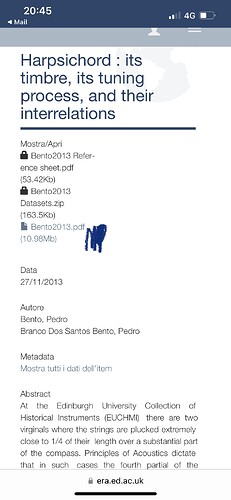 | wgk Wolfgang Knauss
| wgk Wolfgang Knauss
September 23 |
I used the link "Harpsichord: its timbre……” and clicked on the “Show full item record”, but it did not produce the full record. Does someone have the complete version?
Although most UK universities subscribe to the British Library EThOS database, a significant few do not; and some universities have joined or left the scheme over the years. Hence, while O’Brien (1983) is available via EThOS, Bento (2013), from the same university(!) is not.
The EThOS catalogue entry for Bento says ‘Full text unavailable from EThOS. Please try the link below.’ The link below, http://hdl.handle.net/1842/9773,
is to the Edinburgh University repository, from which Bento’s text can be downloaded, although some associated data files cannot.
Bento’s abstract, so readers can decide whether to pursue this, is below:
At the Edinburgh University Collection of Historical Instruments (EUCHMI) there are two virginals where the strings are plucked extremely close to 1/4 of their length over a substantial part of the compass. Principles of Acoustics dictate that in such cases the fourth partial of the resulting sound is unlikely to be produced with any appreciable magnitude. Similar situations affecting different partials also occur when the plucking point is located at other fractional parts of the string length, such as 1/3 or 1/5. A database of plucking points, based on museum catalogues, was created and analysed, so that pitch regions are identified where such phenomena are likely to occur for different categories of instruments. The main cue used in harpsichord tuning is related to beat phenomena produced by partials of two simultaneously played notes, whenever there is a small difference between their frequencies. Partial four being relevant for major thirds and perfect fourths, these intervals may result less accurate, or less reliably tuned, in instruments like the above virginals. Historical sources were surveyed for expressions which describe the cues that tuners were supposed to use in identifying the ideal of an interval. Although expressions such as Schwebungen are mostly related with beats, broader meanings are discussed. Hints of the use of alternative, not beat-related cues, are identified. A series of practical tuning experiments was performed in which selected intervals were tuned, the accuracy of the tuning process being assessed from recordings, which were subjected to spectral analysis. Only cues that could be related to historical sources were used. The effects of factors such as pitch, pitch region, instrument, interval type, and particularly the potential absence of relevant partials were investigated, statistical methods playing a substantial role in the research. A logbook was created, where the experimenter detailed the cues used for each tuned interval in one of the experiments. The recorded information provided some insight into a number of strategies a tuner may use for coping with difficulties in cases of absent or weak partials. The impact of inharmonicity on the exact size of just intervals was also examined, both on theoretical grounds and based on data from the experiments. A number of case studies were included, where a comparison was made between missing partial notes predicted from plucking points and the degree of absence of those partials in the actual spectra for some historical instruments.
